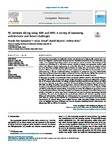5G Network Slicing using SDN and NFV: A Survey of Taxonomy, Architectures and Future Challenges
| dc.contributor.author | Barakabitze, Alcardo Alex | |
| dc.contributor.author | Ahmad, A | |
| dc.contributor.author | Hines, A | |
| dc.contributor.author | Mijumbi, R | |
| dc.date.accessioned | 2019-12-09T16:46:35Z | |
| dc.date.available | 2019-12-09T16:46:35Z | |
| dc.date.issued | 2020-02 | |
| dc.identifier.issn | 1389-1286 | |
| dc.identifier.issn | 1872-7069 | |
| dc.identifier.other | 106984 | |
| dc.identifier.uri | http://hdl.handle.net/10026.1/15232 | |
| dc.description | 40 Pages, 22 figures, published in computer networks (Open Access) | |
| dc.description.abstract |
The increasing consumption of multimedia services and the demand of high-quality services from customers has triggered a fundamental change in how we administer networks in terms of abstraction, separation, and mapping of forwarding, control and management aspects of services. The industry and the academia are embracing 5G as the future network capable to support next generation vertical applications with different service requirements. To realize this vision in 5G network, the physical network has to be sliced into multiple isolated logical networks of varying sizes and structures which are dedicated to different types of services based on their requirements with different characteristics and requirements (e.g., a slice for massive IoT devices, smartphones or autonomous cars, etc.). Softwarization using Software-Defined Networking (SDN) and Network Function Virtualization (NFV)in 5G networks are expected to fill the void of programmable control and management of network resources. In this paper, we provide a comprehensive review and updated solutions related to 5G network slicing using SDN and NFV. Firstly, we present 5G service quality and business requirements followed by a description of 5G network softwarization and slicing paradigms including essential concepts, history and different use cases. Secondly, we provide a tutorial of 5G network slicing technology enablers including SDN, NFV, MEC, cloud/Fog computing, network hypervisors, virtual machines & containers. Thidly, we comprehensively survey different industrial initiatives and projects that are pushing forward the adoption of SDN and NFV in accelerating 5G network slicing. A comparison of various 5G architectural approaches in terms of practical implementations, technology adoptions and deployment strategies is presented. Moreover, we provide a discussion on various open source orchestrators and proof of concepts representing industrial contribution. The work also investigates the standardization efforts in 5G networks regarding network slicing and softwarization. Additionally, the article presents the management and orchestration of network slices in a single domain followed by a comprehensive survey of management and orchestration approaches in 5G network slicing across multiple domains while supporting multiple tenants. Furthermore, we highlight the future challenges and research directions regarding network softwarization and slicing using SDN and NFV in 5G networks. | |
| dc.format.extent | 106984-106984 | |
| dc.language | en | |
| dc.language.iso | en | |
| dc.publisher | Elsevier BV | |
| dc.rights | Attribution 4.0 International | |
| dc.rights | Attribution 4.0 International | |
| dc.rights | Attribution 4.0 International | |
| dc.rights | Attribution 4.0 International | |
| dc.rights | Attribution 4.0 International | |
| dc.rights | Attribution 4.0 International | |
| dc.rights.uri | http://creativecommons.org/licenses/by/4.0/ | |
| dc.rights.uri | http://creativecommons.org/licenses/by/4.0/ | |
| dc.rights.uri | http://creativecommons.org/licenses/by/4.0/ | |
| dc.rights.uri | http://creativecommons.org/licenses/by/4.0/ | |
| dc.rights.uri | http://creativecommons.org/licenses/by/4.0/ | |
| dc.rights.uri | http://creativecommons.org/licenses/by/4.0/ | |
| dc.subject | 5G | |
| dc.subject | SDN | |
| dc.subject | NFV | |
| dc.subject | Network slicing | |
| dc.subject | Cloud/edge computing | |
| dc.subject | Network softwarization | |
| dc.title | 5G Network Slicing using SDN and NFV: A Survey of Taxonomy, Architectures and Future Challenges | |
| dc.type | journal-article | |
| dc.type | Journal Article | |
| plymouth.author-url | https://www.webofscience.com/api/gateway?GWVersion=2&SrcApp=PARTNER_APP&SrcAuth=LinksAMR&KeyUT=WOS:000510524600016&DestLinkType=FullRecord&DestApp=ALL_WOS&UsrCustomerID=11bb513d99f797142bcfeffcc58ea008 | |
| plymouth.volume | 167 | |
| plymouth.publisher-url | http://dx.doi.org/10.1016/j.comnet.2019.106984 | |
| plymouth.publication-status | Published | |
| plymouth.journal | Computer Networks | |
| dc.identifier.doi | 10.1016/j.comnet.2019.106984 | |
| plymouth.organisational-group | /Plymouth | |
| plymouth.organisational-group | /Plymouth/Faculty of Science and Engineering | |
| dcterms.dateAccepted | 2019-11-06 | |
| dc.rights.embargodate | 2019-12-17 | |
| dc.identifier.eissn | 1872-7069 | |
| dc.rights.embargoperiod | Not known | |
| rioxxterms.versionofrecord | 10.1016/j.comnet.2019.106984 | |
| rioxxterms.licenseref.uri | http://creativecommons.org/licenses/by/4.0/ | |
| rioxxterms.type | Journal Article/Review |



